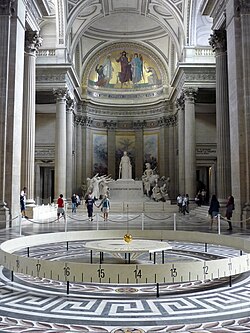
Back نواس فوكو Arabic Péndulu de Foucault AST Fuko kəfkiri Azerbaijani Маятнік Фуко Byelorussian Махало на Фуко Bulgarian ফুকোর দোলক Bengali/Bangla Pèndol de Foucault Catalan Foucaultovo kyvadlo Czech Pendil Foucault Welsh Foucaultpendul Danish

The Foucault pendulum or Foucault's pendulum is a simple device named after French physicist Léon Foucault, conceived as an experiment to demonstrate the Earth's rotation. A long and heavy pendulum suspended from the high roof above a circular area was monitored over an extended time period, showing that its plane of oscillation rotated.
The pendulum was introduced in 1851 and was the first experiment to give simple, direct evidence of the Earth's rotation. Foucault followed up in 1852 with a gyroscope experiment to further demonstrate the Earth's rotation. Foucault pendulums today are popular displays in science museums and universities.[1]
- ^ Oprea, John (1995). "Geometry and the Foucault Pendulum". Amer. Math. Monthly. 102 (6): 515–522. doi:10.2307/2974765. JSTOR 2974765. Archived from the original on 2015-04-02.